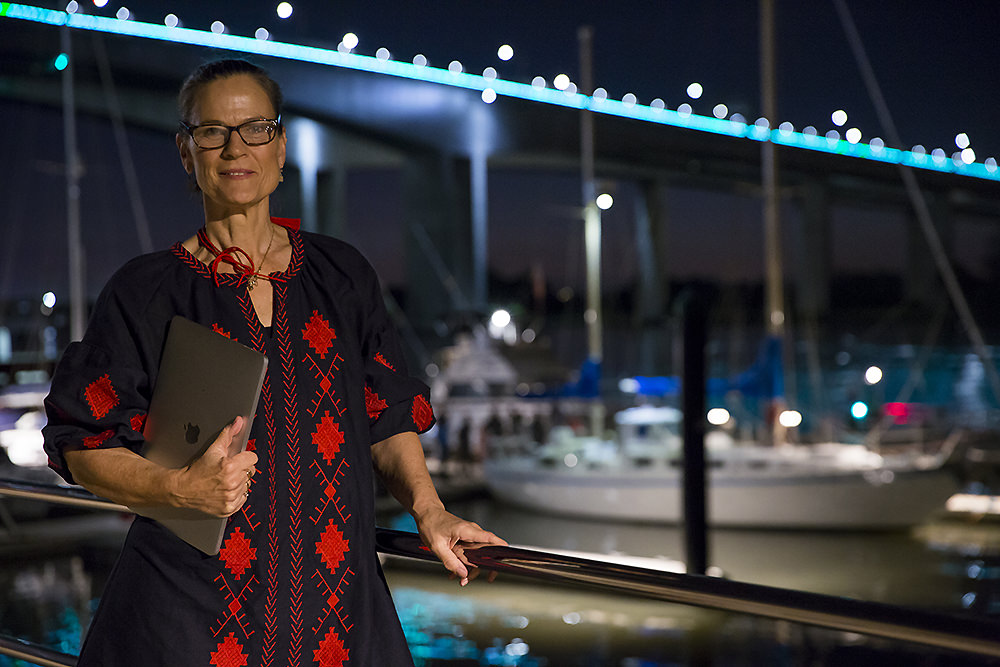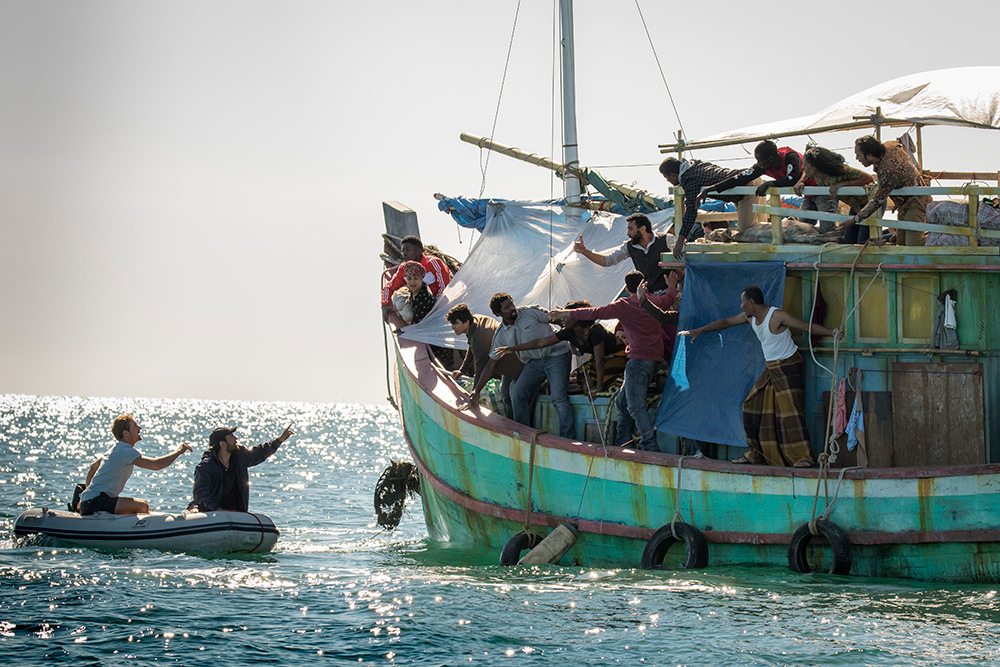Belinda Chayko: lessons from scripting Safe Harbour
Safe Harbour co-writer and showrunner Belinda Chayko breaks down how they mapped out and wrote the complex, compelling drama – and why television is the home for original Australian voices.

Writer Belinda Chayko of Barracuda, Secret City and Fighting Season likes to work in morally grey areas.
So when she came across the idea for Safe Harbour – about five holidaying Australians who cross paths with a broken boat full of asylum seekers – it was the perfect fit.
“I don’t like to work in stories where there’s a clear right and wrong,” Chayko says.
As well as the writer of the series bible, of episode one and four, and co-writer of episode three, Chayko calls herself a ‘kind of’ showrunner of the series. And it’s a big responsibility, because she says depending on who you have creatively driving a series during that development period and beyond, can result in a completely different show.
“I’m there primarily as the guardian of the story,” she says.
The initial idea came from a script by Simon Kennedy who worked on it with Phil Enchelmaier before pitching it to Matchbox Pictures, where Chayko became attached in 2016.
So while it’s not “her baby”, Safe Harbour is more, “a toddler I adopted and hopefully raised well and love dearly.”
She says it’s the most creative stake she’s had in a television project so far.
“It’s the project I’m probably the most proud of in my career.”
Directed by Glendyn Ivin (Seven Types of Ambiguity), who Chayko says was “a joy” to work with, and starring Phoebe Tonkin, Nicole Chamoun, Joel Jackson, Ewen Leslie, Leeanna Walsman, Jacqueline McKenzie, Hazem Shammas and Robert Rabiah, this unmissable Australian drama premieres 8.30pm, Wednesday 7 March on SBS.
PLOTTING TWO TIMEFRAMES AND MULTIPLE VIEWPOINTS
“I had sleepless nights, there’s no doubt about it.”
Over its four-episode arc, Safe Harbour cuts between present day and that fateful holiday five years earlier, revealing bit by bit the different perspectives of the Australians and asylum seekers to paint a full picture of what really happened at sea.
Chayko says because of the complexity of the story, they plotted both a past and present storyline, and one of the biggest challenges was figuring out the balance and where to switch between the two.
“I had sleepless nights, there’s no doubt about it,” she says.
“Script editor Anthony Mullins, who was running the Matchbox Brisbane office at the time, had a fantastic colour-coded system working on the board that allowed us to easily move around the elements of the past and judge how they worked within the present storyline.
“I can’t tell you how many times we looked back over moments from the past storyline, to make sure we weren’t saying too much, but that the audience still had a clear idea of what was happening and that it related to each of the primary episode arcs.
“So a lot of time and effort went into juggling those two elements and getting the mix right.”
Writer of episode two Matt Cameron (Secret City), a frequent collaborator with Chayko, was heavily involved in this stage, to the point where he has a ‘story developed by’ credit.
“He’s quite amazing in terms of plotting and probably the key person I looked to in the room when we’re developing the story, because his instincts are so fantastic.”
To get an idea of the timeline, Chayko says they began brainstorming and plotting in April 2016, working off the document Kennedy and Enchelmaier had put together with the help of Beatrix Christian (Picnic at Hanging Rock). They started off including a lot of backstory, before paring it back and back until it was just what was absolutely necessary. By May 2017, just over a year later, cameras had begun rolling on Safe Harbour.
But even once they were into the shoot, the scripts were continually developing and changing.
“There were things that actors brought and Glendyn brought that again lifted it to another level.”
DELEGATING THE EPISODES
“In my position as kind of showrunner I took the first episode and last episode, because you’re setting up the show and you’re finishing the show,” Chayko says.
“And Matt Cameron who I’ve worked with a lot I really wanted to be part of our team because he is such an incredible story brain. And so Matt was always doing episode two.”
Then emerging writer Phil Enchelmaier, who originally helped developed the idea, came on to co-write episode three.
“There’s a high level of craft involved in getting a story like this right and Phil as a new writer, that’s a really tough call for someone who’s fairly new to the industry, so Phil and I ended up co-writing episode three. But a lot of the episode belongs to Phil and there’s some really beautiful stuff in there. He’s a terrific writer. I think you can see that in the initial idea that Phil and Simon are smart guys, but with just an enormous amount of heart. And that was evident in Phil’s work in the script.”
 Safe Harbour
Safe Harbour
PERSONAL PROCESS
Each writer is different in their approach to writing – some set a word limit, others give themselves an allocated amount of time to write each day. It took Chayko a while to find out what worked best for her.
“For me, pages is the best thing. Every day I set myself a target for a certain number of pages. When things are relaxed, it’s about five pages a day, and that’s just drafting. You’re not getting it perfect and it depends on the amount of research I have to do.”
When she needs to, she can crank out the pages much faster than that, “but quite frankly I think that we should give ourselves the time to write.”
The other thing for Chayko is that she’s the kind of writer that needs to feel the emotions of the characters for it to work.
“If I’m working on an episode that is meant to have an emotional core to it, if I don’t cry at least once in the middle of writing a scene, I actually won’t be happy. I know I haven’t cracked it,” she says.
“I’m a very touchy feely or heart writer. If I don’t feel it, I kind of don’t know what I’m doing.”
And she admits it took some time to find that with Safe Harbour.
“The first drafts were not quite hitting it because I think we hadn’t got inside the skin of the Australians although we were feeling for the asylum seekers. Once we looked at that again, things really shifted and suddenly the whole project opened up.”
It’s also what she relishes about being a showrunner, because she can see the story through to post-production.
“So you are still involved at that late process, giving notes on all the edits, watching all the rushes. You’re able to constantly feed into getting it to the best possible version of what you gave everybody on paper,” she says.
“For example there was a scene that comes in episode four. It’s really beautiful and it was shot gorgeously, but I kept pushing Glendyn and Mark Atkin, the editor, to try a few different things because I knew it was a scene that I should be really undone by and I hadn’t yet felt that.”
She said in the latest cut it moved her to tears – the exact outcome she was hoping for.
MOVING INTO TV FROM FILM
Chayko credits the support of Tony Ayres and Debbie Lee from Matchbox Pictures in helping her transition from film to TV.
Secret City
Back around 2008, Chayko was working on her first feature Lou. Ayres and Michael McMahon’s company Big and Little Films (their company before Matchbox) were trying to raise finance for it, even after securing John Hurt in the lead role. It was around this time Ayres asked her if she would write a TV movie he was too busy to pen, but wanted to direct, called Saved.
“I wrote it, he made it, it was broadcast, and we were still raising the finance for the feature film. And that made me realise something that Tony and others have been saying for a long time: that television is somewhere where things get made.”
Through Ayres’ suggestion, she came on board as a writer on Old School “and it really just steamrolled from there.”
“Old School led to Secret City, and Secret City became Barracuda and yeah, it’s been an amazing ride I’ve got to say – from someone who had a tiny little handfuls of credits because I was writing and directing feature films, to now, making several hours of television every year.
“I love it to death. I’m really privileged. But it is incredibly rewarding when you can see something the whole way through.”
Her hope now is to develop more of her own material for television.
AUSTRALIAN TV BECOMING SHORTER
Television is becoming shorter and Chayko with her feature film background, says she feels these four-part style series, which are almost like extended feature films, are more of a natural fit for her as a storyteller.
“They probably have more relation to a feature than a TV show of old.”
What Chayko really thinks we’re seeing in Australian television, is the opportunity for local talent to shine.
“It’s extraordinary what we’re doing. I just saw ABC’s Riot the other day, I think that’s amazing. And a really difficult show to write given that it was taken from real stories,” she says.
“Then there’s shows like Please Like Me. And I’m a huge fan of No Activity. I really love what Jungle Entertainment do.”
She says television is producing “really unique, individual voices.”
“That’s the different thing about television now, is it is about artistry. And that’s what we’re seeing – we’re seeing storytellers now with a space to express themselves, because it is still very difficult to get films made, but across a number of broadcasters including streaming services, there’s a space for all of these really extraordinary voices now. So I think it’s a really exciting time.”
ADVICE FOR WRITERS
Chayko finds it difficult to pass on any specific advice to emerging writers, because everyone is different in their approach and will find their own way.
But she can say what has worked for her:
- “I had extraordinary supporters.”
- “I didn’t give up – because there were lots of times when being an unpaid feature developer that I was tempted to, but I think persistence is a huge amount of it.”
- “Sticking to your guns. To stay true to the things that I am most excited by and connected to. But also I think it’s listening to other people too. One thing about TV that’s so different to film is you’ve got a lot of voices in your ear and some of those, yes they’re going to drive you nuts, but some are going to help you make something better. ‘Stick to your guns’ means keep to your path, so you know which voices you need to be listening to.”
Catch Safe Harbour on SBS and SBS On Demand from 7 March.

What to read next
Nakkiah Lui on finding humour in tragedy and living out her fantasy of being the best Aboriginal figure skater of all time in Kiki and Kitty.
29 Nov 2017
Caris Bizzaca